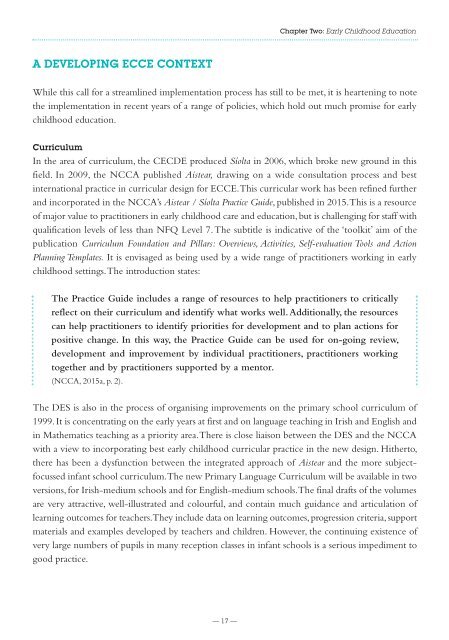Towards a Better Future
A Review of the Irish School System John Coolahan | Sheelagh Drudy Pádraig Hogan | Áine Hyland | Séamus McGuinness
A Review of the Irish School System
John Coolahan | Sheelagh Drudy Pádraig Hogan | Áine Hyland | Séamus McGuinness
Create successful ePaper yourself
Turn your PDF publications into a flip-book with our unique Google optimized e-Paper software.
Chapter Two: Early Childhood Education<br />
A DEVELOPING ECCE CONTEXT<br />
While this call for a streamlined implementation process has still to be met, it is heartening to note<br />
the implementation in recent years of a range of policies, which hold out much promise for early<br />
childhood education.<br />
Curriculum<br />
In the area of curriculum, the CECDE produced Síolta in 2006, which broke new ground in this<br />
field. In 2009, the NCCA published Aistear, drawing on a wide consultation process and best<br />
international practice in curricular design for ECCE. This curricular work has been refined further<br />
and incorporated in the NCCA’s Aistear / Síolta Practice Guide, published in 2015. This is a resource<br />
of major value to practitioners in early childhood care and education, but is challenging for staff with<br />
qualification levels of less than NFQ Level 7. The subtitle is indicative of the ‘toolkit’ aim of the<br />
publication Curriculum Foundation and Pillars: Overviews, Activities, Self-evaluation Tools and Action<br />
Planning Templates. It is envisaged as being used by a wide range of practitioners working in early<br />
childhood settings. The introduction states:<br />
The Practice Guide includes a range of resources to help practitioners to critically<br />
reflect on their curriculum and identify what works well. Additionally, the resources<br />
can help practitioners to identify priorities for development and to plan actions for<br />
positive change. In this way, the Practice Guide can be used for on-going review,<br />
development and improvement by individual practitioners, practitioners working<br />
together and by practitioners supported by a mentor.<br />
(NCCA, 2015a, p. 2).<br />
The DES is also in the process of organising improvements on the primary school curriculum of<br />
1999. It is concentrating on the early years at first and on language teaching in Irish and English and<br />
in Mathematics teaching as a priority area. There is close liaison between the DES and the NCCA<br />
with a view to incorporating best early childhood curricular practice in the new design. Hitherto,<br />
there has been a dysfunction between the integrated approach of Aistear and the more subjectfocussed<br />
infant school curriculum. The new Primary Language Curriculum will be available in two<br />
versions, for Irish-medium schools and for English-medium schools. The final drafts of the volumes<br />
are very attractive, well-illustrated and colourful, and contain much guidance and articulation of<br />
learning outcomes for teachers. They include data on learning outcomes, progression criteria, support<br />
materials and examples developed by teachers and children. However, the continuing existence of<br />
very large numbers of pupils in many reception classes in infant schools is a serious impediment to<br />
good practice.<br />
— 17 —



